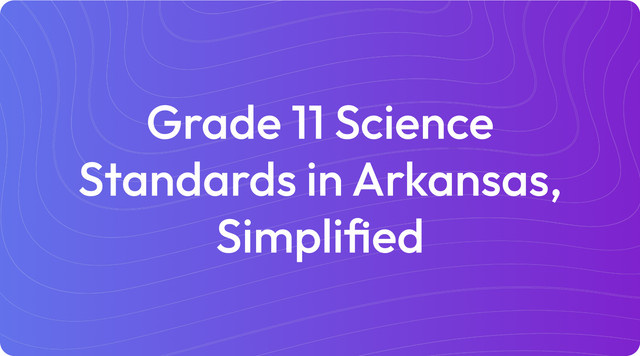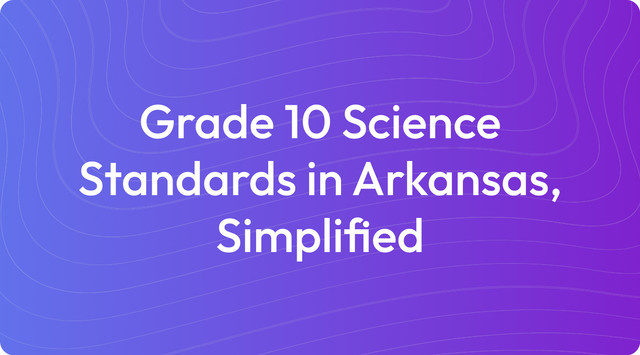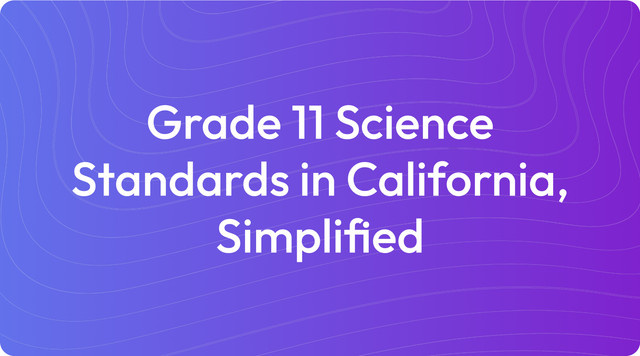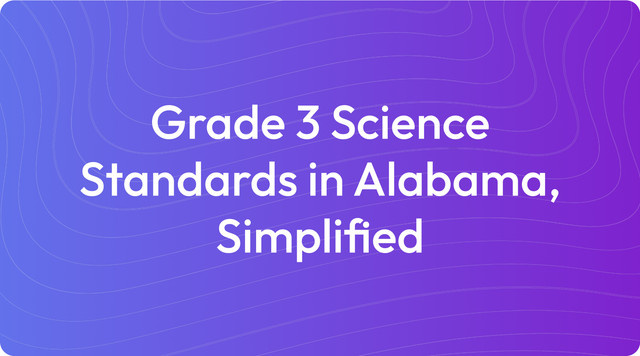Grade 11 Science Standards in Arkansas, Simplified
Grade 11 in Arkansas offers Chemistry or Physics, with options for electives like Anatomy and AP courses. Read more now.

Education standards form the foundation of curriculum planning, but they can often feel complex. We understand the work involved in aligning lessons with state requirements. Our goal is to provide you with clear, practical tools to help you meet these expectations without adding to your workload.
Education standards are learning goals that outline what students should know by the end of a course. For teachers, this means structuring your curriculum to cover specific skills and concepts. For example, Arkansas's 11th-grade science standards expect students in a Chemistry class to understand topics like atomic structure and chemical reactions, which are part of the HS-PS1 standard for Matter and Its Interactions.
What Are Grade 11 Science Standards in Arkansas?
In Arkansas, 11th-grade science standards provide a clear path for students, typically focusing on either Chemistry or Physics. These courses build upon earlier learning in Physical Science and Biology, introducing more advanced concepts. Here is an overview of the standards, course options, and graduation requirements for Grade 11.
Grade 11 Science Standards
The specific standards depend on which core science course a student takes:
- Chemistry Standards (Common Grade 11 Course):
- HS-PS1: Matter and Its Interactions covers atomic structure, periodic trends, chemical bonds, conservation of mass, reaction rates, and energy in chemical reactions.
- HS-PS2: Motion and Stability explores forces and interactions at the molecular and atomic level, such as intermolecular forces.
- HS-PS3: Energy focuses on energy relationships within physical and chemical processes.
- HS-ETS1: Engineering Design involves applying chemistry concepts to solve real-world problems like those in materials science.
- Physics Standards (Alternative Grade 11 Course):
- HS-PS2: Motion and Stability includes Newton’s laws of motion, as well as gravitational and electromagnetic forces.
- HS-PS3: Energy covers energy conservation, transfer, and work-energy relationships.
- HS-PS4: Waves and Their Applications addresses wave properties, electromagnetic waves, and how waves transfer energy.
- HS-ETS1: Engineering Design involves designing and testing solutions based on physics principles.
- Elective Standards (Varies by School):
- Environmental Science (HS-ESS3): Focuses on natural resources, human impacts on the environment, and sustainability.
- Advanced Biology or Anatomy and Physiology (HS-LS1, HS-LS2): Offers a deeper exploration of life science topics, such as organ systems or ecosystems.
Science Subjects Available for Grade 11
Core Options
- Chemistry: The most common choice, this course centers on atomic and molecular interactions, chemical reactions, and energy transfer, providing a foundation for students pursuing STEM fields.
- Physics: An alternative core class that focuses on motion, forces, energy, and wave behavior, often taken by students interested in engineering or technology.
Elective Options (Varies by School)
- Environmental Science: Explores sustainability, ecosystems, and human-environment interactions.
- Anatomy and Physiology: A detailed study of human body systems and their functions.
- Earth and Space Science: The study of geology, astronomy, and Earth’s systems.
- Forensic Science: The application of biology and chemistry to crime scene investigations.
- Marine Biology: The study of aquatic ecosystems and marine life.
- Agricultural Science: Applies biology and environmental science concepts in agriculture.
Advanced Placement (AP) Courses
- AP Biology: An advanced study of cell biology, genetics, ecosystems, and evolution.
- AP Chemistry: An in-depth study of chemical reactions, stoichiometry, and thermodynamics.
- AP Physics 1/2: Algebra-based physics courses covering concepts like motion, energy, and waves.
- AP Environmental Science: A course with a real-world focus on sustainability, resources, and ecosystems.
Graduation Requirements in Arkansas
To graduate, students must earn three science credits. Many schools recommend the following sequence:
- 1 Credit in Physical Science: Can be fulfilled by Physical Science, Chemistry, or Physics.
- 1 Credit in Biology: Or a similar life science course.
- 1 Additional Science Credit: Can be an elective like Environmental Science, Chemistry, or Physics.
- Grade 9: Physical Science
- Grade 10: Biology
- Grade 11: Chemistry or Physics
- Grade 12: An elective such as Environmental Science, Anatomy, or an AP course
The framework for these standards is guided by national models and state-level implementation. For more information, you can review the topic arrangements from the Next Generation Science Standards and resources from the Arkansas Division of Elementary and Secondary Education.
Key Tested Standards
In Arkansas, the key tested standards for 11th-grade science depend on whether a student is taking Chemistry or Physics. Assessments for both courses center on foundational physical science concepts that prepare students for future work in STEM fields. Here are the specific standards you can expect to see tested for each subject.
Key Tested Standards for Chemistry
Physical Science (PS)
- HS-PS1: Matter and Its Interactions
- HS-PS1-1: Use the periodic table to predict properties of elements based on their atomic structure.
- HS-PS1-2: Model how atoms interact and bond to form molecules.
- HS-PS1-4: Conduct experiments to show how energy is absorbed or released during chemical reactions (endothermic and exothermic reactions).
- HS-PS1-7: Use mathematical representations to support the conservation of mass in chemical reactions.
- HS-PS3: Energy
- HS-PS3-4: Investigate how energy is transferred in chemical and physical processes.
Key Tested Standards for Physics
Physical Science (PS)
- HS-PS2: Motion and Stability: Forces and Interactions
- HS-PS2-1: Analyze data to explain the relationship between force, mass, and acceleration (Newton’s Second Law).
- HS-PS2-2: Use free-body diagrams and mathematical models to predict the motion of objects based on forces acting on them.
- HS-PS2-4: Use evidence to explain how gravitational and electromagnetic forces act at a distance.
- HS-PS3: Energy
- HS-PS3-1: Create models to describe how energy is conserved and transferred within systems.
- HS-PS3-3: Design and analyze systems where energy is converted between different forms (e.g., mechanical to thermal energy).
- HS-PS4: Waves and Their Applications
- HS-PS4-1: Use mathematical models to describe wave properties such as frequency, wavelength, and speed.
- HS-PS4-3: Explain how electromagnetic waves are used to transfer data and energy.
Key Cross-Cutting Skills
Beyond the core content, assessments also measure the following cross-cutting skills:
- Modeling: Students must create and use models to describe physical and chemical systems.
- Data Analysis: Interpreting experimental results, graphs, and equations to support scientific conclusions
- Problem-Solving: Students must apply mathematical formulas (e.g., Newton’s laws or stoichiometry) to solve real-world problems.
- Energy Relationships: Understanding the transfer and conservation of energy across systems is a focus in both Chemistry and Physics
Graduation Requirement Connection
Students must complete three science credits to graduate, and Chemistry or Physics is often taken in Grade 11 to fulfill the Physical Science credit requirement.
The standards and requirements outlined are based on information from the Next Generation Science Standards and the Arkansas Division of Elementary and Secondary Education.
Example Learning Objectives for Unit Planning
Learning objectives break down broad standards into clear, student-friendly goals. They define what students should be able to do after a lesson, making it easier to plan activities and measure progress. These specific targets help you align your instruction directly with state requirements.
Here are examples of learning objectives for Grade 11 science standards in Arkansas, focusing on Chemistry. These objectives align with NGSS-based standards and are written in student-friendly language:
Standard: HS-PS1-1
(Use the periodic table to predict properties of elements based on their atomic structure.)
- I can explain how the periodic table is organized by atomic number, groups, and periods.
- I can predict the reactivity of elements based on their placement in the periodic table.
- I can identify trends in properties such as electronegativity, atomic radius, and ionization energy.
Standard: HS-PS1-4
(Conduct experiments to show how energy is absorbed or released in chemical reactions.)
- I can describe the difference between endothermic and exothermic reactions.
- I can analyze temperature changes in a reaction to determine if energy is absorbed or released.
- I can explain how breaking and forming chemical bonds is related to energy changes in a reaction.
Standard: HS-PS1-7
(Use mathematical representations to support the conservation of mass in chemical reactions.)
- I can balance chemical equations to show that matter is conserved.
- I can use stoichiometry to calculate the amounts of reactants and products in a reaction.
- I can explain how the law of conservation of mass applies to all chemical reactions.
Standard: HS-PS2-1
(Analyze data to show the relationship between force, mass, and acceleration.)
Learning Objectives (If Physics is taught in Grade 11):
- I can use Newton’s second law to calculate the force, mass, or acceleration of an object.
- I can analyze graphs to interpret how changes in force or mass affect acceleration.
- I can conduct experiments to observe how force and mass influence motion.
Standard: HS-PS3-4
(Investigate energy transfer in chemical and physical processes.)
- I can describe how energy transfers during a phase change (e.g., melting, boiling).
- I can explain how energy is transferred as heat in chemical reactions.
- I can evaluate how energy transformations obey the law of conservation of energy.
Key Changes & Updates
The Grade 11 science standards in Arkansas were updated in 2015 to align with the Next Generation Science Standards (NGSS). This shift introduced a "three-dimensional learning" model, which combines scientific practices like conducting experiments, core content in chemistry and physics, and crosscutting concepts that connect different topics. The new standards place a greater emphasis on inquiry-based learning, where students investigate real-world phenomena. For example, a chemistry lesson might explore why some reactions release heat, while a physics class could examine how roller coasters use energy transfer to function safely.
In practice, these updates mean that instruction is now centered on Performance Expectations, where students demonstrate their understanding by doing science—not just memorizing it. This includes designing experiments, analyzing data to support claims, and applying mathematical models to solve problems. Engineering principles are also integrated, encouraging students to design solutions for practical challenges. The goal of these changes is to foster critical thinking and hands-on skills, giving students a stronger foundation for future coursework and careers in STEM fields.
Create with TeachShare
We know that turning these complex standards into engaging lessons takes time and effort. Our platform is designed to help you build high-quality, standards-aligned materials quickly, so you can focus more on teaching and less on prep work. Start creating standards-aligned instructional resources with TeachShare now.
Frequently Asked Questions
What are the major changes in the updated NGSS-aligned standards?
The updated standards shift the focus from memorization to application. They integrate three key dimensions: Science and Engineering Practices, Crosscutting Concepts, and Disciplinary Core Ideas. This approach encourages students to use their knowledge to explain real-world phenomena and solve problems, demonstrating their understanding through performance-based tasks rather than just tests.
What topics are covered in Grade 11 Science?
In Grade 11, students in Arkansas typically choose between Chemistry and Physics. Here’s a brief overview of the topics for each course:
- Chemistry: Covers atomic structure, the periodic table, chemical bonding and reactions, stoichiometry, energy changes, and properties of matter like solubility and acids.
- Physics: Focuses on motion, forces, Newton’s laws, energy conservation, waves, sound, light, and the fundamentals of electricity and magnetism.
How do these standards prepare students for the future?
These standards build a strong foundation for students, whether they plan to take advanced courses like AP Chemistry and AP Physics or pursue careers in STEM fields. By focusing on problem-solving and analysis, students develop critical thinking and quantitative reasoning skills that are valuable for any college or career path.
What are some examples of real-world applications in Grade 11 Science?
The standards encourage connecting classroom concepts to everyday life. For example:
- In Chemistry, students can explore the combustion reactions that power vehicles or understand the chemical properties that make cleaning products effective.
- In Physics, they might analyze the principles of motion and energy that make a roller coaster work or investigate how waves are used for communication in devices like cell phones.
How are these standards assessed in Arkansas?
Assessment in Arkansas for Chemistry and Physics is typically done through classroom-based evaluations. Instead of just multiple-choice tests, students are often asked to demonstrate their knowledge by analyzing experimental data, creating models of chemical reactions or physical systems, and applying mathematical concepts to solve practical problems.
Answer







